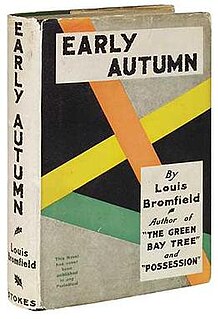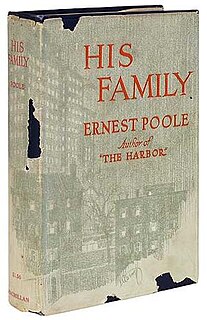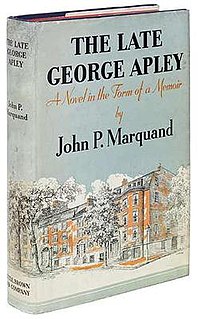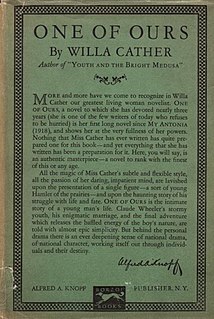 W
WThe Able McLaughlins is a 1923 novel by Margaret Wilson first published by Harper & Brothers. It won the Pulitzer Prize for the Novel in 1924. It won the Harper Prize Novel Contest for 1922-23, the first time the prize was awarded. Wilson published a sequel, The Law and the McLaughlins, in 1936.
 W
WThe Age of Innocence is a 1920 novel by American author Edith Wharton. It was her twelfth novel, and was initially serialized in 1920 in four parts, in the magazine Pictorial Review. Later that year, it was released as a book by D. Appleton & Company. It won the 1921 Pulitzer Prize for Fiction, making Wharton the first woman to win the prize. Though the committee had initially agreed to give the award to Sinclair Lewis for Main Street, the judges, in rejecting his book on political grounds, "established Wharton as the American 'First Lady of Letters'". The story is set in the 1870s, in upper-class, "Gilded-Age" New York City. Wharton wrote the book in her 50s, after she had established herself as a strong author, with publishers clamoring for her work.
 W
WAlice Adams is a 1921 novel by Booth Tarkington that received the 1922 Pulitzer Prize for the Novel. It was adapted as a film in 1923 by Rowland V. Lee and more famously in 1935 by George Stevens. The narrative centers on the character of a young woman who aspires to climb the social ladder and win the affections of a wealthy young man named Arthur Russell. The story is set in a lower-middle-class household in an unnamed town in the Midwest shortly after World War I.
 W
WAll the King's Men is a novel by Robert Penn Warren first published in 1946. Its title is drawn from the nursery rhyme Humpty Dumpty. In 1947, Warren won the Pulitzer Prize for All the King's Men. It was adapted for a film in 1949 and 2006; the 1949 version won the Academy Award for Best Picture; the 2006 version was a massive failure. It is rated as the 36th greatest novel of the 20th century by Modern Library, and it was chosen as one of Time magazine's 100 best novels since 1923.
 W
WArrowsmith is a novel by American author Sinclair Lewis, first published in 1925. It won the 1926 Pulitzer Prize. Lewis was greatly assisted in its preparation by science writer Paul de Kruif, who received 25% of the royalties on sales, although Lewis was listed as the sole author. Arrowsmith is an early major novel dealing with the culture of science. It was written in the period after the reforms of medical education flowing from the Flexner Report on Medical Education in the United States and Canada: A Report to the Carnegie Foundation for the Advancement of Teaching, 1910, which had called on medical schools in the United States to adhere to mainstream science in their teaching and research.
 W
WA Bell for Adano is a 1944 novel by John Hersey, the winner of the 1945 Pulitzer Prize for the Novel. It tells the story of an Italian-American officer in Sicily during World War II who wins the respect and admiration of the people of the town of Adano by helping them find a replacement for the town bell that the Fascists had melted down for rifle barrels.
 W
WThe Bridge of San Luis Rey is American author Thornton Wilder's second novel, first published in 1927 to worldwide acclaim. It tells the story of several interrelated people who die in the collapse of an Inca rope bridge in Peru, and the events that lead up to their being on the bridge. A friar who witnesses the accident then goes about inquiring into the lives of the victims, seeking some sort of cosmic answer to the question of why each had to die. The novel won the Pulitzer Prize in 1928, and was the best-selling work of fiction that year.
 W
WDragon's Teeth is a 1942 novel by Upton Sinclair that won the Pulitzer Prize for the Novel in 1943. Out of print and nearly forgotten for years, ebook editions of the Lanny Budd series were published in 2016. Set in the period 1929 to 1934, it covers the Nazi takeover of Germany during the 1930s.
 W
WEarly Autumn is a 1926 novel by Louis Bromfield. It won the Pulitzer Prize for the Novel in 1927. In 1956, producer Benedict Bogeaus announced that he was adapting the book into a film to be titled "Conquest," but the film was never made.
 W
WGone with the Wind is a novel by American writer Margaret Mitchell, first published in 1936. The story is set in Clayton County and Atlanta, both in Georgia, during the American Civil War and Reconstruction Era. It depicts the struggles of young Scarlett O'Hara, the spoiled daughter of a well-to-do plantation owner, who must use every means at her disposal to claw her way out of poverty following Sherman's destructive "March to the Sea". This historical novel features a coming-of-age story, with the title taken from the poem “Non Sum Qualis eram Bonae Sub Regno Cynarae”, written by Ernest Dowson.
 W
WThe Good Earth is a novel by Pearl S. Buck published in 1931 that dramatizes family life in a Chinese village in the early 20th century. It is the first book in her House of Earth trilogy, continued in Sons (1932) and A House Divided (1935). It was the best-selling novel in the United States in both 1931 and 1932, won the Pulitzer Prize for Fiction in 1932, and was influential in Buck's winning the Nobel Prize for Literature in 1938. Buck, who grew up in China as the daughter of missionaries, wrote the book while living in China and drew on her first-hand observation of Chinese village life. The realistic and sympathetic depiction of the farmer Wang Lung and his wife O-Lan helped prepare Americans of the 1930s to consider Chinese as allies in the coming war with Japan.
 W
WThe Grapes of Wrath is an American realist novel written by John Steinbeck and published in 1939. The book won the National Book Award and Pulitzer Prize for fiction, and it was cited prominently when Steinbeck was awarded the Nobel Prize in 1962.
 W
WHis Family is a novel by Ernest Poole published in 1917 about the life of a New York widower and his three daughters in the 1910s. It received the first Pulitzer Prize for the Novel in 1918.
 W
WHoney in the Horn is a 1935 debut novel by Harold L. Davis. The novel received the Harper Prize for best first novel of 1935 and won the Pulitzer Prize for the Novel in 1936. The title of the book is from a line in a square dancing tune, and is only found in the book in the author's introductory overleaf.
 W
WIn This Our Life is a 1941 novel by the American writer Ellen Glasgow. It won the Pulitzer Prize for the Novel in 1942. The title is a quote from the sonnet sequence Modern Love by George Meredith: "Ah, what a dusty answer gets the soul/ When hot for certainties in this our life!"
 W
WJourney in the Dark is a 1943 novel by Martin Flavin. It won both the 1943 Harper Prize and the 1944 Pulitzer Prize, and was printed as an Armed Services Edition. The New York Times called the book "a story of a boy from Iowa who becomes a business tycoon at the price of his integrity.”
 W
WLamb in His Bosom is a 1933 novel by Caroline Miller. It won the Pulitzer Prize for the Novel in 1934. It also won the Prix Femina in 1934 and became an immediate best-seller. Many names and historical parts of this book were contributed by William Avery McIntosh, of Mt. Pleasant, Wayne County, Georgia. His only child, a daughter, is still living in Northeast Georgia.
 W
WThe Late George Apley is a 1937 novel by John Phillips Marquand. It is a satire of Boston's upper class. The title character is a Harvard-educated WASP living on Beacon Hill in downtown Boston. It is an epistolary novel, made up mostly of letters to and from the title character.
 W
WLaughing Boy is a 1929 novel by Oliver La Farge about the struggles of the Navajo in Southwestern United States to reconcile their culture with that of the United States. It won the Pulitzer Prize in 1930.
 W
WThe Magnificent Ambersons is a 1918 novel by Booth Tarkington, the second in his Growth trilogy after The Turmoil (1915) and before The Midlander. It won the Pulitzer Prize for fiction and was adapted into the 1925 silent film Pampered Youth. In 1942 it was again made into a movie, this time under its own title, with sound, and to a tightly clipped but effective script by Orson Welles, who also directed. Much later, in 2002, came a TV adaptation based on Welles' screenplay.
 W
WNow in November is a 1934 novel by Josephine Johnson. It received the Pulitzer Prize for the Novel in 1935.
 W
WOne of Ours is a novel by Willa Cather that won the 1923 Pulitzer Prize for the Novel. It tells the story of the life of Claude Wheeler, a Nebraska native in the first decades of the 20th century. The son of a successful farmer and an intensely pious mother, he is guaranteed a comfortable livelihood. Nevertheless, Wheeler views himself as a victim of his father's success and his own inexplicable malaise.
 W
WScarlet Sister Mary is a 1928 novel by Julia Peterkin. It won the Pulitzer Prize for the Novel in 1929. The book was called obscene and banned at the public library in Gaffney, South Carolina. The Gaffney Ledger newspaper, however, serially published the complete book. Dr. Richard S. Burton, the chairperson of Pulitzer's fiction-literature jury, recommended that the first prize go to the novel Victim and Victor by John Rathbone Oliver. His nomination was superseded by the School of Journalism's choice of Peterkin's book. Evidently in protest, Burton resigned from the jury.
 W
WSo Big is a 1924 novel written by Edna Ferber. The book was inspired by the life of Antje Paarlberg in the Dutch community of South Holland, Illinois, a Chicago suburb. It won the Pulitzer Prize for the Novel in 1925.
 W
WThe Store is a 1932 novel by Thomas Sigismund Stribling. It won the Pulitzer Prize for the Novel in 1933. It is the second book of the Vaiden trilogy, comprising The Forge, The Store, and Unfinished Cathedral. All three books in the trilogy have been kept in print since the mid-1980s by the University of Alabama Press.
 W
WThe Yearling is a novel by Marjorie Kinnan Rawlings published in March 1938. It was the main selection of the Book of the Month Club in April 1938. It was the best-selling novel in America in 1938 and the seventh-best in 1939. It sold over 250,000 copies in 1938. It has been translated into Spanish, Chinese, French, Japanese, German, Italian, Russian and 22 other languages. It won the 1939 Pulitzer Prize for the Novel.
 W
WYears of Grace is a 1930 novel by Margaret Ayer Barnes. It won the Pulitzer Prize for the Novel in 1931. Despite this, it is not her most well-known work; that honor belongs to Dishonored Lady, a play she co-wrote with Edward Sheldon, which was adapted twice into film.